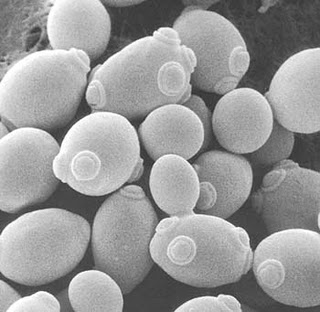Creating multicellular life in vitro
For a long time, biologists have been trying to understand the origin of complex life forms from single-celled microorganisms that evolved into reproductive forms of multicellular organisms.
The single-cell yeast cells in the laboratory will sprout off single-celled yeast cells. The continuous yeast reactions with the challenge of difficult living conditions led to the formation of spiky multicellular yeast in only about two months, according to Will Ratcliff, working at the University of Minnesota Twin Cities, USA. . Experiments show that the process of protozoan yeast cells developing into multicellular yeast occurs more easily than previously thought. The results of this study were presented by Ratcliff at the Conference on Evolution that took place on June 18, 2011.

Pictures of budding yeast,
electron microscopy observation
According to evolutionary biologists, the transition from single-celled organisms to multicellular organisms is one of the major transitions in the history of life . "It is possible to test this by experimenting, in real time, in the laboratory, this is really a very interesting thing ," Dugatkin said.
To stimulate evolution in vitro, Ratcliff and his colleagues introduced suspension to interact with yeast cells daily. Each tube contains yeast cells that are lightly rotated by a centrifuge. Later, the researchers retained the residue deposited in each tube and discarded the rest. This is necessary to ensure that any change in yeast is also intended to solve the problem, such as a change: formation of multicellular yeast, due to the needs of survival. .
Under these conditions, unicellular yeasts tend to retain budding daughter cells rather than isolate them by the need for survival under the daily effects, creating erect multicellular organisms. which researchers call enamel flowers.
These snowflake yeast clones by breaking crack into smaller pieces that eventually grow and fracture themselves . Researchers even suggest that this may be a form of fertility division, Ratcliff said. A glaze of snowflakes scatters dead cells, or kills cells, and the drawback is that they act as broken lines in smaller pieces peeling off.
To find out if snowflake yeast grows like multicellular organisms? Researchers have created a different version of snow flower yeast to cope with changes that are faster or more severe. Snowflake yeasts received care in the harshest environment reacted significantly, becoming snowflake yeast with a size of 2 times larger than the original snow flower yeast. That means that these snowflake yeasts respond well to evolutionary pressures as a whole, multicellular organisms, Ratcliff said.
Experiments that led to the emergence of snow flower yeast far surpassed the research that was reported in 1998 by other scientists who developed a form of a multicellular bacterium but does not describe its evolutionary dynamics.
The experiment led to the emergence of snow flower yeasts, which did not help determine the exact start time of multicellular yeast, right when it comes to the evolution of multicellular yeast, according to the warning by Adam Waite, who is involved in yeast research cooperation at the University of Washington, in Seattle, USA, because today's single-celled yeast actually progressed from a multicellular precursor long ago.
Although, Dugatkin did not recognize this drawback. However, whether single-cell yeasts have the same way to grow into multicellular yeast today, just like how the first multicellular organisms formed, billions of years ago, he said, this is really an interesting question.
- Discover Cambrian multicellular fossil fossil in China
- The process of creating babies in test tubes
- When should I do in vitro fertilization?
- Multicellular organisms may exist before the Cambrian Period
- Things to know about in vitro fertilization
- In vitro fertilization fee will be only 5.4 million
- The explosions of life
- Root the explosion of life on Earth
- Successful breeding of sperm in vitro
- Find the deepest animal
- Will in-vitro fertilization be at risk of premature death?
- Protein discovery decides to conceive successfully
 Why do potatoes have eyes?
Why do potatoes have eyes? 'Tragedy' the world's largest carnivorous life: Death becomes ... public toilet
'Tragedy' the world's largest carnivorous life: Death becomes ... public toilet Tomatoes were once considered 'poisonous' for 200 years
Tomatoes were once considered 'poisonous' for 200 years Detecting microscopic parasites on human face
Detecting microscopic parasites on human face